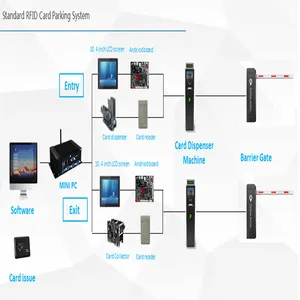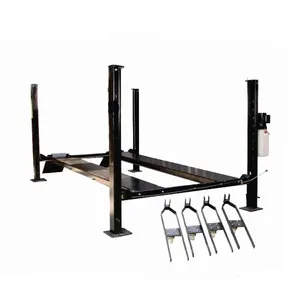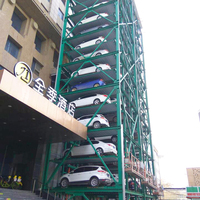
Self Vending Machine Automatic Parking Lot Payment System Rfid Card Dispenser Car Parking Smart Card Parking System


3T Manual 1 Side Lock Release System Hydraulic Car Lift Parking Price Rain Coat For Choice Hydraulic Car Lift Garage Hoist















As cities swell and skyscrapers rise, the quest for space becomes ever more pressing. In the heart of this urban puzzle lies a critical challenge: where to park an ever-growing number of cars. 'Maximizing Urban Space: The Rise of Elevated Car Parking Solutions' delves into the innovative realm of multistorey car parks, a response to the scarcity of urban land. This article explores the evolution, design, and technological advancements of elevated parking systems that promise to redefine the urban landscape by taking parking to new heights—literally and figuratively.
The early 20th century marked a significant shift in urban transportation, with motor vehicles surpassing horse-drawn wagons in production and becoming the dominant force on roads. This surge in vehicle numbers necessitated the development of traffic regulations and the invention of parking rules. Pioneers like William Phelps Eno were instrumental in creating traffic plans for major cities and introducing traffic control features such as stop signs and taxi stands. The concept of 'ranking' and 'parking' emerged, with 'live' and 'dead' designations indicating whether a driver was present. As cities grappled with the challenges of vehicle storage, the inefficiency of parallel curb parking led to the exploration of off-street parking solutions. Angled parking, once seen as an efficient use of space, eventually gave way to concerns over safety and traffic flow, prompting cities to reconsider and regulate parking practices. This historical evolution sets the stage for understanding the rise of elevated car parking solutions as a response to the growing need for efficient urban space management.

Elevated car parking systems, also known as multistorey car parks, are structures designed to accommodate a large number of vehicles across multiple levels. These parking solutions are integral in urban landscapes where ground space is limited. By stacking parking spaces vertically, they maximize the use of vertical space, allowing for more efficient land use in densely populated areas.
The design of these structures varies, with some featuring long floor spans that allow for rows of parking without supporting columns in between, enhancing parking efficiency. Others may adopt a short-span design, often found beneath high-rise buildings, where the need for more frequent support columns can reduce parking efficiency.
Modern elevated parking systems may incorporate advanced materials and technologies, such as precast concrete components for rapid construction and carbon-fiber-reinforced polymers for enhanced strength and corrosion resistance. These materials are particularly beneficial in climates where de-icing salts are used, as they offer greater durability against such corrosive elements.
Elevated parking structures are not only functional but can also be designed with architectural value in mind, potentially serving as an aesthetic addition to urban developments. They are often equipped with features such as expansion joints to accommodate thermal expansion and the flexing of the structure due to vehicle traffic, ensuring long-term structural integrity.
Elevated car parking systems have revolutionized the way urban spaces optimize parking capacity. Alibaba.com offers a diverse range of these solutions, catering to different needs and scenarios. Among the types available, the Semi-Automatic Smart Vertical Car Parking Equipment stands out for its puzzle-like arrangement, enhancing space utilization vertically. The Electric 4 Post Hydraulic Car Lifts and the Hydraulic Double Level Car Elevator are designed for robust performance and are suitable for both commercial and residential buildings.
Space-saving designs are further exemplified by Multi Levels Rotating Car Parking Systems, which provide a dynamic parking solution by rotating vehicles to available spaces. For heavy-duty requirements, the Customized Heavy-duty Truck Lift and the Mechanical Double Deck 2 Post Car Parking Lift offer sturdy support and efficient space management. Automated systems like the Tower Parking and Robotic Carousel rotary parking system introduce automation for a seamless parking experience.
For those seeking simple yet effective solutions, the 2 Posts Simple Car Parking Lifts and the Single Post elevador estacionamiento provide a minimalistic approach to car parking. On the other end of the spectrum, the Hydraulic 8 columns car parking lift showcases the capability to handle multiple vehicles simultaneously, indicating the versatility of elevated parking solutions available on the platform. Each of these systems is designed with a focus on maximizing space, efficiency, and user convenience.
Innovative technologies in parking management have revolutionized the efficiency and security of elevated car parking systems. Advanced automated solutions, such as valet vehicle tracking and license plate recognition, streamline the parking process, enhancing the user experience from arrival to departure. These systems often include features like bar code inventory for tracking, which integrates seamlessly with property management systems, providing real-time vehicle location updates.
The use of wireless handheld devices and cloud-based software in these parking solutions offers real-time shift reporting and customized reports, ensuring financial security and data protection. Automated parking access control systems contribute to reduced operational expenses and improved customer satisfaction by allowing remote resolution of service issues. These features collectively work towards maximizing revenue collection and mitigating potential problems within the parking operation.
Moreover, the validation process in these parking systems is self-managed, utilizing straightforward and expandable technology. This ensures accountability and provides detailed reporting features that are essential for maintaining control over revenue and customer service quality. The integration of such smart technologies in elevated car parking solutions not only creates a seamless experience for customers but also acts as a proactive measure to prevent damage claims and enhance overall satisfaction.
Elevated car parking structures benefit significantly from the integration of long-span composite decking, which combines steel's strength with concrete's durability. This material choice not only facilitates ease of construction but also ensures longevity and low maintenance. The composite deck acts as a permanent formwork, contributing to the tensile strength of the slab throughout its lifespan.
The design flexibility offered by composite decking is notable. It allows for thin-slab floors that optimize building height and floor-to-floor spacing. With the ability to support clear spans of up to 36 feet, these structures can accommodate a range of vehicle capacities and sizes, enhancing maneuverability within the parking facility.
In terms of construction, the composite decking's rigidity and strength enable the integration of mechanical, electrical, and plumbing services in an efficient manner. The potential for optimized placement of weight-bearing walls contributes to the structural integrity and allows for wider vehicle stalls.
For parking garages in specific climates, there are tailored solutions that reduce the use of concrete by up to 40 percent compared to traditional methods, without compromising on safety, as fire endurance ratings of up to four hours can be achieved. This approach not only supports environmental considerations but also offers economic advantages.

Elevated car parking solutions, often seen as a modern alternative to traditional parking structures, offer a range of benefits. These systems are designed to minimize the footprint of parking areas by stacking vehicles vertically, which can be particularly advantageous in urban settings where space is at a premium. Unlike sprawling traditional parking lots, elevated systems are more cost-effective to construct, primarily due to their reduced land usage and the potential for lower material costs.
The efficiency of elevated parking systems is another significant advantage. By stacking cars, these structures make better use of vertical space, often resulting in a smaller overall area required for the same number of vehicles. This can be crucial in densely populated areas or in locations where expansion of horizontal space is limited or prohibitively expensive.
Furthermore, the choice between traditional and elevated parking solutions can be influenced by the specific requirements of a project. For instance, if the need for a large number of parking spaces is not coupled with ample space, elevated car parking systems can provide an effective solution. They serve to maximize the utility of limited space while ensuring that parking demands are met, aligning with the growing need for smarter, space-conscious urban planning.
A challenge was faced when over a thousand employees and visitors competed for limited parking spots. To manage this, a smart parking management system that provided real-time occupancy information with minimal sensors was implemented. The solution utilized strategically placed cameras to monitor large areas, ensuring efficient use of space and privacy compliance.
The system's adaptability was demonstrated through a pilot study that evolved into a permanent solution, effectively overseeing both car and motorbike parking spaces. This approach negated the need for costly and disruptive ground sensors, instead leveraging existing infrastructure for a streamlined implementation.
The impact of this smart parking solution was significant, easing the tasks of security officers and enabling dynamic space allocation. The interactive dashboard and analytics tools provided essential data for monthly reporting, while also addressing the misuse of parking spaces by long-term parkers through an enforcement module.
This case study exemplifies the successful integration of smart parking solutions in an urban corporate setting, highlighting the potential for such systems to alleviate parking pressures and enhance the efficiency of space usage in densely populated areas.
When selecting an elevated car parking solution, it's essential to consider the variety of systems available. The platform offers a range of parking lifts suitable for different settings, including commercial and residential garages. Options include two-post car lifts, which are a compact solution for smaller spaces, and multi-level systems that maximize parking capacity in larger areas.
Elevated car parking systems come in various configurations such as semi-automatic smart vertical parking equipment, hydraulic lifts, and rotating parking systems. Each type has its own set of features tailored to specific parking needs. For instance, semi-automatic systems provide a balance between manual and fully automated parking, while hydraulic solutions offer a durable and robust mechanism for lifting vehicles.
The construction of these parking structures uses materials designed to ensure stability and longevity. When browsing, it's important to assess the materials used in each system, as well as the technology that supports the operation of the parking solution. This could include safety features, space-saving design, and the system's adaptability to different vehicle sizes.
Finally, consider the benefits that each elevated parking solution offers, such as space optimization, improved parking experience, and compatibility with various vehicle types. The range of parking systems is designed to address the challenges of urban parking by providing efficient, space-saving solutions that cater to a diverse market.

In conclusion, elevated car parking solutions represent a significant leap forward in urban design and functionality. By stacking vehicles vertically, these structures offer a space-efficient alternative to traditional parking lots, addressing the acute shortage of urban space. The case studies and diverse options available underscore the adaptability and efficiency of these systems. From semi-automatic to fully automated, from simple lifts to complex rotating systems, elevated parking solutions are reshaping the way cities manage the ever-increasing demand for vehicle storage. As we continue to build upwards, these innovative structures stand as a testament to human ingenuity, offering a blend of aesthetic appeal, technological sophistication, and practical efficiency that is essential for the sustainable development of urban environments.